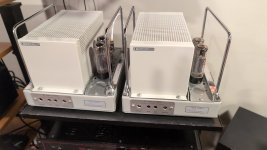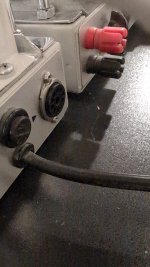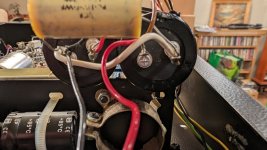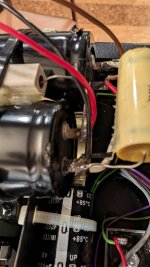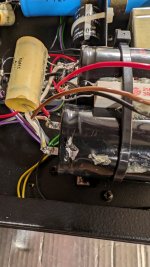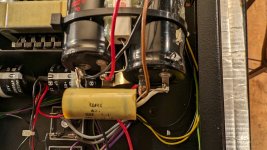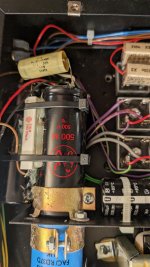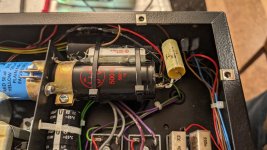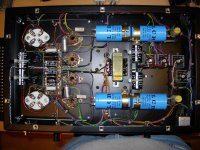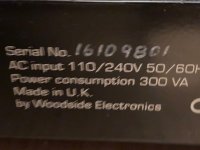Just counting the number of chokes and the number of (presumably) B+ capacitors of 500VDC rating in a (nominally) 500VDC supply, I'd sure start with sketching out the power supply into even a primitive schematic. The OPTs look like British AudioNotes from the era (hot pants!) so these are likely well worth the effort.
All good fortune,
Chris
All good fortune,
Chris
Unfortunately, no scope. I’m just about to see if it will take full voltage. Fingers crossed.Do you have a scope? If so, watch the voltage ripple on the B+ as the Variac increases.
Up to 85 volts. Some clicking on the speakers, then got quiet, and 38 mV on the test points. So far, so good.
At 100 volts the fuse went south. I think this is what happened prior to its 10 year hiatus.
What should I do next?
What should I do next?
It could in some cases though it may just recover usually. Sometimes you get grid to filament shorts or just a change in gain characteristics.
I would work on it upside down. Slowly increase voltage on the variac and see if the voltages on the 811 test points ramp up right or go bad. Check other assorted voltages while increasing power.
Maybe also note what voltage exists on the 3.3K plate resistors on the 5881s for each side.
If you have a grid to filament short on the 811-10 you may notice a flicker in the intensity from the filament.
You could also power it up without the 811-10s. If it is a bad filter cap or rectifier, you may find it this way.
Edit -Another thing to check is how much voltage is on the power supply caps. I see 500v caps and the plate supply is supposed to be 500. Could be pushing your luck on cap voltage. Of course do with clips and not probing with your hands.
I would work on it upside down. Slowly increase voltage on the variac and see if the voltages on the 811 test points ramp up right or go bad. Check other assorted voltages while increasing power.
Maybe also note what voltage exists on the 3.3K plate resistors on the 5881s for each side.
If you have a grid to filament short on the 811-10 you may notice a flicker in the intensity from the filament.
You could also power it up without the 811-10s. If it is a bad filter cap or rectifier, you may find it this way.
Edit -Another thing to check is how much voltage is on the power supply caps. I see 500v caps and the plate supply is supposed to be 500. Could be pushing your luck on cap voltage. Of course do with clips and not probing with your hands.
Actually, the fuse is good… but the amplifier shut down.
Ok, did you understand the previous post? Work on it upside down.
Discharge the main filter caps and measure them. Given that one has already been replaced, how bad could the others be?What should I do next?
jeff
OK, amp upside down from now on. I see what happened now, it took out the 3A slo-blo fuse in my Variac.You do not want to operate the 811-10s horizontally. Only upside down or up. The filament can sag across the grid.
Last edited:
Be careful about the Variac fuse, do not over-rate it, or the Variac could be ruined.
Also the amplifier fuse must be sized to protect the Variac wiper.
Or else add an extra series fuse specifically for the wiper.
Also the amplifier fuse must be sized to protect the Variac wiper.
Or else add an extra series fuse specifically for the wiper.
OK, tomorrow I'll have to get some 3A slo-blo fuses for the Variac to protect it rather than putting in a 5A. I expect I'll keep blowing the 3A fuse in the Variac with a 5A fuse in the amp. It did make it to 100 volts! As you can tell, I'm new to this.
IMO that 500uF JJ cap is very suspicious and probably has no business being in there. I'm guessing somebody thought to give the amp more OOMPH by adding all that capacitance, but that can cause real problems. It may be the cause of the blown fuses.
Honestly, unless you're a skilled DIYer, I would find someone to help you map out the power supply and do some testing without the tubes to see where the short is.
Honestly, unless you're a skilled DIYer, I would find someone to help you map out the power supply and do some testing without the tubes to see where the short is.
We must remember that 100 Volts and 3 Amps is 300 Watts that disappeared somewhere into your amplifier, appearing as heat. This is not a good way to troubleshoot. "First, do no harm."
All good fortune,
Chris
All good fortune,
Chris
If it happens to be a bad cap it could like spew acid and chunks if you finally kill it with an appropriate voltage.
I think you're onto something. There are actually two (2) 500uF JJ caps in that spot zip tied together along with that big ceramic resistor. I'll take some better photos for you of the area tomorrow. I wonder if there is someone locally who can help me map out the power supply here in Regina, Saskatchewan, Canada. I can also check with Radford Revival to see if they have access to the power supply schematic .. it's been a few years since I've contacted them other than recently while I was looking for a couple of pull and turn voltage selector switches for a pair of Radford MA-25 mono blocks I've got running again. I wired them internally but it would be nice to have the original switches in place. You can see the switch behind one but the pull and turn part is missing. Anyone have a couple to spare?IMO that 500uF JJ cap is very suspicious and probably has no business being in there. I'm guessing somebody thought to give the amp more OOMPH by adding all that capacitance, but that can cause real problems. It may be the cause of the blown fuses.
Honestly, unless you're a skilled DIYer, I would find someone to help you map out the power supply and do some testing without the tubes to see where the short is.
Attachments
Last edited:
The two suspicious 500uF JJ caps. I pulled them out of their holder so you can see the poor job someone made of it at some point in its history. This may well be the problem.
Attachments
Last edited:
1000uF. Madonuzza santa. What people do to their poor tube amps. It could be that the bridge rectifier is blown or at least one diode is shorted.
That's a nice amp. See if you can find someone to help with it.
That's a nice amp. See if you can find someone to help with it.
778 / 5.000
Hello everybody I just registered on the forum. It is indeed a very unusual amplifier with an impressive sound. I have one purchased in January 1999 from the distributor in my country. In these 25 years I have not had any problems and no modification has been made except to change the 6LS7 and put some NOS valves, I have only used it with Svetlana's 811-10 but I understand that it is the same valve as the 572-10 I have no idea about electronics. I can solder cables or change a resistor but little else... The fuse you ask about is 3.15 A and 250V. The stages are somewhat different. Mine is serial number 16109801. It looks like they are from the same day. Either mine has one more capacitor or yours is missing one. I'll send you a photo in case it helps you.
Hello everybody I just registered on the forum. It is indeed a very unusual amplifier with an impressive sound. I have one purchased in January 1999 from the distributor in my country. In these 25 years I have not had any problems and no modification has been made except to change the 6LS7 and put some NOS valves, I have only used it with Svetlana's 811-10 but I understand that it is the same valve as the 572-10 I have no idea about electronics. I can solder cables or change a resistor but little else... The fuse you ask about is 3.15 A and 250V. The stages are somewhat different. Mine is serial number 16109801. It looks like they are from the same day. Either mine has one more capacitor or yours is missing one. I'll send you a photo in case it helps you.
Attachments
- Home
- Amplifiers
- Tubes / Valves
- Woodside Electronics SET-30 - Help!
